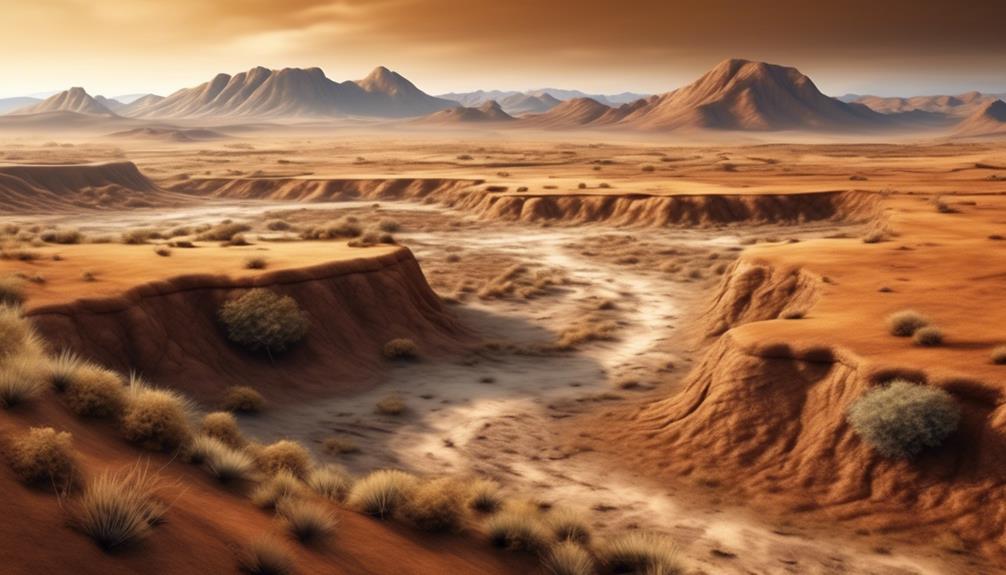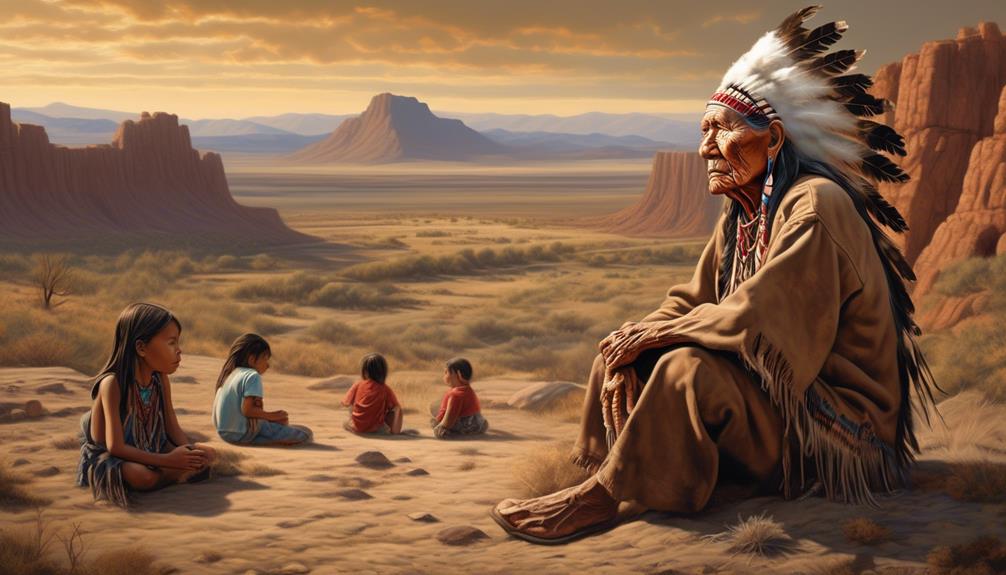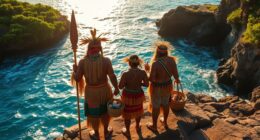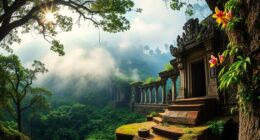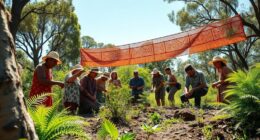After enduring a severe drought, a rancher released their cows onto a barren piece of land, hoping that the animals would find something to graze on. Unfortunately, without any vegetation to hold the soil in place, the ground started to erode.
This phenomenon is not limited to drought-stricken areas; it occurs in various landscapes worldwide. The implications of livestock or indigenous animals removing vegetation, leaving the soil vulnerable to erosion, are far-reaching and demand our attention.
Understanding the mechanisms behind this process and exploring potential solutions is crucial for sustainable land management.
Key Takeaways
- Livestock or indigenous animals that remove vegetation contribute to soil erosion and disrupt the ecosystem's equilibrium.
- The removal of vegetation by grazing leads to a loss of biodiversity and imbalance in the ecosystem.
- Soil degradation and increased vulnerability to erosion occur when there is no vegetation.
- Implementing sustainable land management practices is crucial for protecting the environment and ensuring productivity.
Impact of Vegetation Removal
Vegetation removal significantly accelerates soil erosion and disrupts the natural equilibrium of the ecosystem. When vegetation is removed, the roots that once held the soil together decompose, leading to decreased soil stability. This destabilization makes the soil more susceptible to erosion by wind and water. As a result, the topsoil, which is crucial for plant growth, is easily washed or blown away, further exacerbating the problem.
Moreover, the removal of vegetation disrupts the ecological balance by impacting the diverse interactions between plants, animals, and microorganisms. This disruption can lead to a decrease in biodiversity and the loss of essential habitat for many organisms. Additionally, the absence of vegetation reduces the amount of organic matter returning to the soil, affecting its fertility and overall health.
Grazing Behavior and Soil Erosion
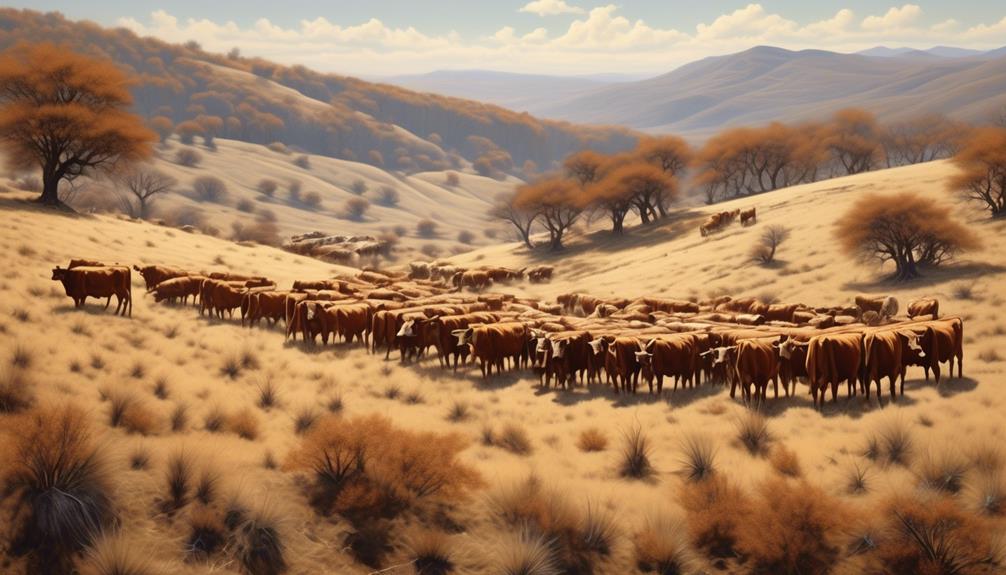
Analyzing the impact of livestock and indigenous animals grazing on soil erosion reveals critical insights into sustainable land management practices. Grazing behavior significantly influences soil protection and erosion. Understanding the grazing impact is crucial for implementing effective land conservation strategies.
| Grazing Impact | Soil Protection |
|---|---|
| Intensive grazing | Decreases soil stability |
| Selective grazing | Alters vegetation composition |
| Overgrazing | Exposes soil to erosion |
Intensive grazing, where animals concentrate on specific areas for extended periods, decreases soil stability and compacts the ground, making it more susceptible to erosion. Selective grazing, common among many herbivores, alters the composition of vegetation by favoring certain plant species over others. This can lead to a reduction in overall vegetation cover, leaving the soil more exposed. Overgrazing exacerbates these issues by further reducing vegetation cover and exposing the soil to erosion processes.
Understanding the intricate relationship between grazing behavior and soil erosion is vital for implementing sustainable land management practices. By managing grazing patterns and intensities, land managers can effectively protect the soil from erosion while ensuring the well-being of livestock and indigenous animals.
Erosion Control Strategies
We can address the impact of grazing behavior on soil erosion by implementing effective erosion control strategies that aim to protect the soil and promote sustainable land management practices. To achieve this, it's crucial to employ the following erosion control methods:
- Prevention is Key
Implementing physical barriers such as fences or hedgerows to control the movement of livestock and indigenous animals, thereby reducing their impact on vegetation and soil.
- Soil Conservation through Revegetation
Introducing and promoting the growth of native vegetation to stabilize the soil, enhance its structure, and reduce the risk of erosion. Revegetation also aids in restoring the natural balance of the ecosystem.
Ecological Consequences
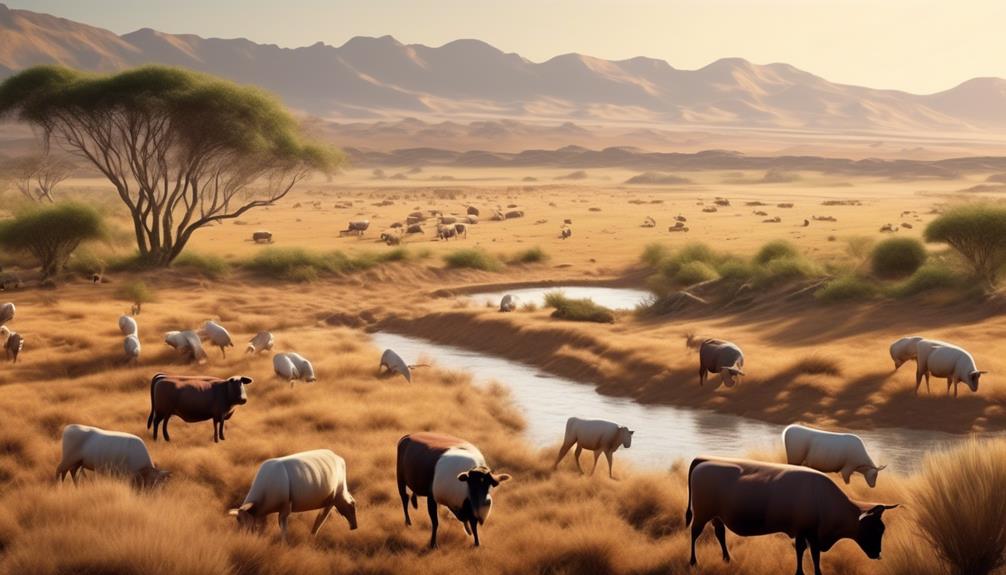
Frequently, the presence of grazing livestock and indigenous animals significantly impacts the ecological balance of the surrounding area, altering the natural dynamics of the ecosystem. The consequences of vegetation removal by these animals include biodiversity loss and ecosystem imbalance. When large areas of vegetation are consumed, it leads to a reduction in the variety of plant species and disrupts the delicate balance of the ecosystem. This can have far-reaching effects on other species dependent on the affected plants, potentially leading to population declines and even local extinctions.
Furthermore, the removal of vegetation by grazing livestock and indigenous animals can result in soil degradation and increased vulnerability to erosion. Without the stabilizing effect of vegetation, soil can be easily washed away by rainwater, leading to sedimentation in water bodies. This can cause water pollution and negatively impact aquatic life, further exacerbating the ecological consequences.
Sustainable Land Management
The impact of grazing livestock and indigenous animals on soil erosion necessitates the implementation of sustainable land management practices to mitigate ecological imbalances and protect the environment. Sustainable land management is crucial for addressing the challenges posed by soil erosion and ensuring the long-term productivity of agricultural land.
Here are key points to consider:
- Integrated Soil Conservation: Implementing measures such as contour plowing, terracing, and strip cropping can effectively prevent soil erosion by reducing water runoff and promoting soil stability.
- Utilizing cover crops and crop rotation techniques can further enhance soil conservation efforts, maintaining soil health and fertility.
- Promoting Sustainable Agriculture: Encouraging sustainable agricultural practices, such as organic farming and agroforestry, can help minimize the environmental impact of farming activities while preserving the natural balance of ecosystems.
- Embracing precision farming techniques, including the use of advanced technologies for efficient resource management, contributes to sustainable agriculture and minimizes soil erosion.
Frequently Asked Questions
What Are the Specific Grazing Patterns of Indigenous Animals That Contribute to Soil Erosion?
We need to understand the specific grazing patterns of indigenous animals that contribute to soil erosion.
Indigenous animal grazing habits play a crucial role in the environmental impact, particularly on soil erosion and vegetation removal.
By studying indigenous practices, we can gain valuable insights into how these animals interact with their environment and how their grazing behavior affects soil stability.
This knowledge can inform sustainable land management practices in areas where indigenous animals roam.
How Do Different Types of Livestock Impact the Soil's Vulnerability to Erosion?
When we consider the impact of different types of livestock on soil erosion, it's crucial to understand the significance of overgrazing. Overgrazing can drastically reduce soil fertility and leave it vulnerable to erosion.
Proper livestock management practices play a pivotal role in erosion prevention.
Interestingly, studies show that overgrazing contributes to 85% of soil erosion in grasslands.
Understanding and addressing these impacts is essential for sustainable land use and environmental conservation.
Are There Any Cultural or Traditional Practices Related to Livestock Grazing That Impact Soil Erosion?
Cultural traditions often shape grazing impact and soil erosion management. Sustainable practices, rooted in indigenous knowledge, offer traditional methods for preserving the land. By respecting these practices, we can learn valuable techniques for sustainable grazing and soil conservation.
These cultural traditions provide insights into the delicate balance between livestock management and environmental sustainability, offering valuable lessons for modern land stewardship.
Can Vegetation Removal by Indigenous Animals Have Different Effects on Soil Erosion Compared to Human-Induced Deforestation?
We must consider the impact of indigenous animals' vegetation removal on soil erosion compared to human-induced deforestation.
Indigenous animals' grazing patterns and cultural practices may have different long-term implications on soil erosion and local ecosystem impact.
Understanding the differences in vegetation removal between indigenous animals and human deforestation is crucial for managing and mitigating soil erosion in diverse landscapes.
What Are the Long-Term Implications of Soil Erosion Caused by Livestock Grazing on the Local Ecosystem?
The long-term ecosystem impact of soil erosion caused by livestock grazing is significant. The consequences include diminished soil fertility, increased sedimentation in water bodies, and disrupted nutrient cycles.
This can lead to climate change implications such as reduced carbon sequestration and increased greenhouse gas emissions. Additionally, soil erosion from livestock grazing can threaten biodiversity preservation, impacting the local flora and fauna.
Conclusion
In conclusion, when livestock or indigenous animals remove vegetation, it can leave the soil vulnerable to erosion. This can have significant impacts on the land and surrounding ecosystems.
It's important for us to consider sustainable land management practices to mitigate these effects and protect our natural environment. Let's work together to ensure the health and vitality of our land for future generations to enjoy.
